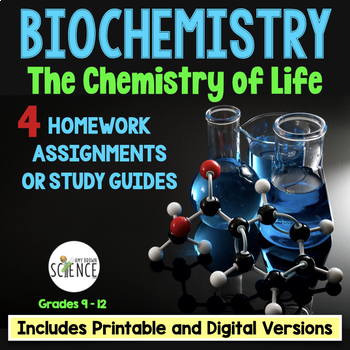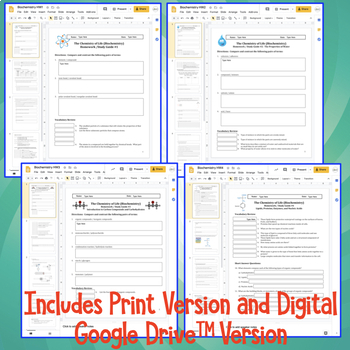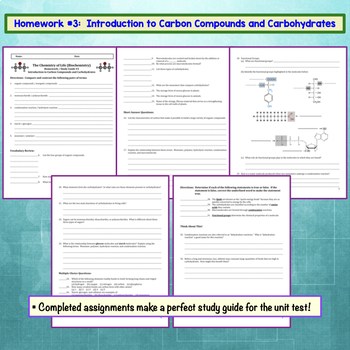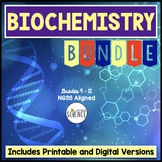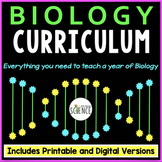Biochemistry Worksheets - 4 Homework Assignments
- Zip
- Google Apps™

Also included in
- This complete teaching unit on "Biochemistry: The Chemistry of Life" includes everything you need to teach this unit to your life science or biology students. Many of the resources are available in BOTH printable and digital formats. Resources include an 88-Slide Powerpoint presentation packed witPrice $45.99Original Price $60.45Save $14.46
- This NO PREP, PRINTABLE, EDITABLE, AND DIGITAL Biology Curriculum contains everything you need for an entire year of Biology! For less than $3 a day, you can save your time, energy, and sanity. Each of the 20 Complete Units includes a teaching PowerPoint presentation, notes, labs, homework assignmenPrice $525.00Original Price $988.18Save $463.18
Description
Use this set of 4 printable or digital homework assignments or study guides on biochemistry and macromolecules to provide your students with quality homework assignments for your "chemistry of life" lessons. This resource contains 20 student pages consisting of 167 questions. As I teach my unit on biochem, I assign a portion of these questions for homework each night. The completed homework assignments provide thorough study guides for the unit test. You can also use a few questions during class each day to check for student understanding of the concepts being taught.
Both printable and digital versions of this resource are included. The student handouts can be printed or used in the paperless digital format in your Google Drive, Google Classroom, Microsoft OneDrive, or similar. This resource is perfect for traditional classroom settings, 1:1 schools, or for distance learning.
What is included in your download folder?
- Printable and Editable Homework Assignments / Study Guides (Set of 4)
- Digital paperless versions (not editable) for use in Google Drive, Google Classroom, and/or Microsoft OneDrive
- Teacher Guide and Answer Key
- Teacher guide for Google Apps Versions
Homework 1: The Nature of Matter and Chemical Bonding
- The Nature of Matter: Atoms, subatomic particles, mass and charges of the subatomic particles.
- Elements: Definitions, isotopes, radioactive isotopes, practical uses of radioactive isotopes, the nature of compounds.
- Chemical Bonds: Definitions and examples of ionic and covalent bonds, polar molecules, polar covalent bonds, nonpolar covalent bonds.
Homework #2: The Properties of Water
- Properties of Water: The polarity of water molecules, hydrogen bonding, hydrogen bonds in ice, liquid water, and water vapor, cohesion and adhesion.
- Mixtures, Solutions, and Suspensions: Definitions, homogeneous and heterogenous solutions, solute, solvent.
- Reasons why water makes life possible.
- Acids, Bases, and pH: The pH scale, definitions of acids and bases, buffers, why buffers are essential to the life of a cell.
Homework #3: Introduction to Carbon Compounds and Carbohydrates
- Carbon Compounds: The difference between organic and inorganic compounds, the characteristics of carbon that allow for the building of a large variety of biological molecules.
- Functional Groups: Definition of functional group and their role in chemical reactions. Four common functional groups are covered: Hydroxyl, carboxyl, amino, and phosphate groups.
- Macromolecules: Definition of macromolecule, groups of macromolecules, polymerization, monomers, polymers, condensation reactions, hydrolysis reactions.
- Carbohydrates: Examples of carbohydrates, characteristics of carbohydrates, building blocks or monomers of carbohydrates, functions of carbohydrates in cells, monosaccharides, disaccharides, polysaccharides, starch, glycogen, cellulose.
Homework #4: Lipids, Proteins, Enzymes, and Nucleic Acids
- Lipids: Examples of lipids, characteristics of lipids, building blocks or monomers of lipids, nonpolar nature of lipids, fatty acids, glycerol, saturated and unsaturated fats, triglycerides, phospholipids, waxes.
- Proteins: Examples of proteins, characteristics of proteins, building blocks or monomers of proteins, the structure of amino acids, dipeptides, polypeptides, the relationship between shape and function of proteins.
- Enzymes: Definitions and the role of enzymes in cells, equation for how an enzyme works, substrate molecules, active site, products.
- Nucleic Acids: Brief introduction to nucleic acids, two types of nucleic acids, building blocks of nucleic acids.
All answers are included in the very detailed 14 page teacher guide that is included with this product.
The questions are of varying difficulty levels. Question types include compare and contrast, matching, fill in the blank, short answer, graphing, calculations, and modified true/false. Questions range from very basic to questions requiring problem solving and critical thinking.
Related Products Include:
Biochemistry Macromolecules PowerPoint and Notes Set
Macromolecules Color by Number Activity
Organic Compounds Mix/Match Game
Properties of Water Color by Number
Biology Buzz Words: Biochemistry and The Chemistry of Life
Set of 2 Biochemistry Jeopardy Review Games
Biochemistry Google Sheets Hidden Picture Reveal Activities - 4 Game Set
Organic Compounds Graphic Organizer
Testing for Organic Compounds in Foods
FREE Enzyme Catalase Lab Activity
Lab: The Release of Heat in an Enzymatic Reaction
For updates about sales and new products, please follow my store:

